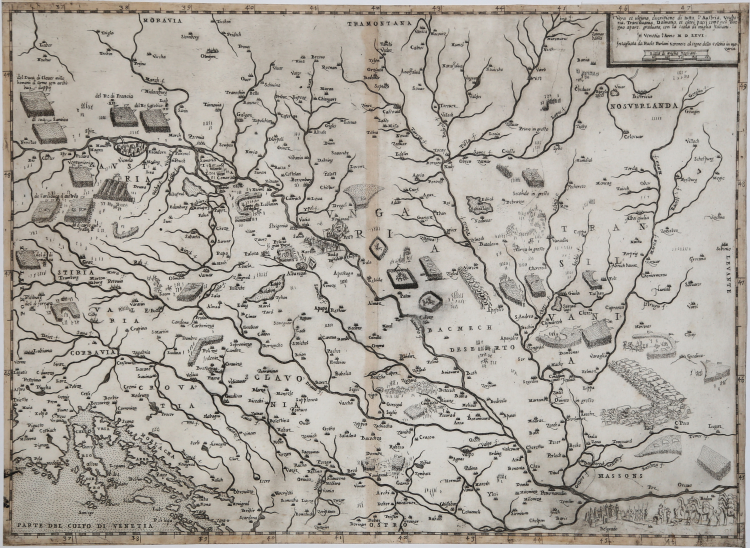



| Reference: | S38504 |
| Author | Paolo FORLANI |
| Year: | 1566 |
| Zone: | Austria & Hungary |
| Printed: | Venice |
| Measures: | 487 x 352 mm |


| Reference: | S38504 |
| Author | Paolo FORLANI |
| Year: | 1566 |
| Zone: | Austria & Hungary |
| Printed: | Venice |
| Measures: | 487 x 352 mm |
Etching with engraving, printed on contemporary laid paper with "Tulips in circle with six-pointed star" watermark (Woodward 121-123), with original added margins, very good condition.
The map depicts Austria, Hungary, Transylvania and adjacent regions. For all its geographical elements, it derives from "Il dissegno particolare delle Regioni che sono da Costantinopoli, a Venetia, da Venetia a Viena et da Viena a costantinopoli" by Giacomo Gastaldi (1559, see Bifolco-Ronca, No. 228).
The map, signed by Paolo Forlani, is a faithful replica of the work of Domenico Zenoi (Bifolco-Ronca No. 490) of the same year. It depicts the war events in the region, affected by the war between the Austro-Hungarian troops of Maximilian II of Augburg and the Turkish ones of the sultan Suleiman the Magnificent, which ended with the siege of Szigetvár (September 8, 1566).
Almagià claims that the plate is antecedent; however the Forlani, unlike what was done by Zenoi,
he does not mention the event in the title, suggesting that the work is simply a copy
made for commercial reasons.
The work knew only one issue and, judging by the number the recorded examples in the sixteenth century collections, obtained a good diffusion.
Literature:
Almagià (1927): n. 50; Bifolco (2018): n. 101; Borroni Salvadori (1980): n. 278; Castellani (1876): n. 27;
Christie’s (2004): n. 448; Christie’s Pa (2006): n. 198; De Vries (1981): n. 23; Ganado (1982): n. 28; Kraus (1972): n. 37; National Maritime Museum (1971): n. 126; Parke-Bernet (1969): n. 31; Ruge (1904-16): IV, n. 85.31 & n. 89.36; Shirley (2004): I, n. 61; Sotheby’s (2005): n. 45; Wieder (1915): p. 6, n. 45 & p. 28, n. 27; Banfi (1947a): n. 2; Cartografia Rara (1986): n. 15; Száantai (1996): pp. 184-5; Szathmáry (1987): n. 65; Tooley (1939): n. 124; Woodward (1990): n. 45.
|
Bifolco-Ronca, Cartografia e Topografia Italiana del XVI secolo, Catalogo ragionato delle opera a stampa (2018), pp. 1166-1167, tav. 491.
|
Paolo FORLANI (Attivo a Venezia seconda metà del XVI secolo)
|
Paolo Forlani, a native of Verona, opened his own chalcographic workshop in Venice, Al segno del pozzo, in 1560, as reflected in some of his works. From 1566 he was active in Merzaria al segno della colonna and from 1569 in Merzaria al segno della nave. Forlani had business relationships with the major publishers of cartographic material of the time, among them Antonio Lafreri, the Bertelli family, and others. In addition to being a talented engraver, he was also quick to execute, a quality that enabled him to work for different publishers at the same time, and to execute a large amount of work. Woodward attributes about one hundred works to Forlani, most of which, however, are unsigned. Between 1560 and 1567, Forlani collaborated with Ferrando Bertelli, for whom he engraved about ten copperplates, with Camocio, Bolognino Zaltieri, and with Claudio Duchetti, for whom he engraved some maps. For his professional activity, however, the collaboration with Giacomo Gastaldi, for whom he engraved thirteen maps, was very important and valuable. In 1567 Forlani published and traded his work Il primo libro delle città et fortezze principali del mondo, whose branches later passed to Bolognino Zaltieri. It is likely that Forlani died during the plague that spread through Venice from 1575.
|
|
Bifolco-Ronca, Cartografia e Topografia Italiana del XVI secolo, Catalogo ragionato delle opera a stampa (2018), pp. 1166-1167, tav. 491.
|
Paolo FORLANI (Attivo a Venezia seconda metà del XVI secolo)
|
Paolo Forlani, a native of Verona, opened his own chalcographic workshop in Venice, Al segno del pozzo, in 1560, as reflected in some of his works. From 1566 he was active in Merzaria al segno della colonna and from 1569 in Merzaria al segno della nave. Forlani had business relationships with the major publishers of cartographic material of the time, among them Antonio Lafreri, the Bertelli family, and others. In addition to being a talented engraver, he was also quick to execute, a quality that enabled him to work for different publishers at the same time, and to execute a large amount of work. Woodward attributes about one hundred works to Forlani, most of which, however, are unsigned. Between 1560 and 1567, Forlani collaborated with Ferrando Bertelli, for whom he engraved about ten copperplates, with Camocio, Bolognino Zaltieri, and with Claudio Duchetti, for whom he engraved some maps. For his professional activity, however, the collaboration with Giacomo Gastaldi, for whom he engraved thirteen maps, was very important and valuable. In 1567 Forlani published and traded his work Il primo libro delle città et fortezze principali del mondo, whose branches later passed to Bolognino Zaltieri. It is likely that Forlani died during the plague that spread through Venice from 1575.
|